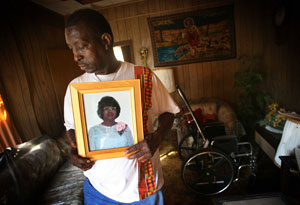Top News
A year after Katrina, it still hurts
By Jacqui Goddard (timesonline)
Updated: 2006-08-30 10:13
 |
Large Medium Small |
It started with the mournful sound of a lone trumpet on a bridge overlooking the flood-ravaged landscape of New Orleans. Then came the wreaths, the tears and a jazz parade.
 Herbert Freeman with his late mother's portrait in his abandoned New Orleans home [timesonline] |
An army of politicians led by President Bush arrived in the region for commemorations that began with sombre ceremonies and ended in New Orleans with a traditionally upbeat jazz funeral parade.
But it was the pain of the people that spoke the loudest. "Mr President, are you going to turn your back on me?" a waitress asked Mr Bush as he passed by during a visit to a devastated New Orleans neighbourhood.
"No ma'am, not again," replied the President — whose Administration's slow response to the catastrophe drew heavy criticism.
Among the displaced residents who returned to pay their respects yesterday was Herbert Freeman, who says that the city, state and federal governments did turn their backs on him and his 91-year-old mother, Ethel, in their hour of need.
He rescued his disabled mother from the tide, placed her on a boat and pushed it for two miles through chest-high water to the convention centre, where he was told that there would be medical help, food and evacuation buses. There was nothing and, after two days in the squalor and chaos, the frail widow died.
"I shook her and she didn't answer. My mama was gone," Mr Freeman, 59, recalls. He watched over her corpse for another two days but, when buses finally arrived, the National Guard ordered him at gunpoint on to a vehicle that took him to Alabama, leaving the body untended.
Photographs of Mrs Freeman's corpse slumped in a wheelchair and abandoned for days in the hot sun became one of the most indelible images of Hurricane Katrina's aftermath, epitomising a city's agony and a nation's shame.
"This anniversary is important. It will help me to let the world know what happened, how the system failed my mama, but that she's home now with God," said her son, who nursed, clothed and fed his bed-bound mother at home for the last five years of her life.
He added: "It's going to be painful and then it's going to be sort of joyous in a way, knowing that people haven't forgotten what happened to this place, to these people. It was so wrong."
Their house in New Orleans is like a time capsule from the day they left it. Bedsheets are still turned back from the moment that he lifted her out and into a boat and her spare wheelchair is folded in a corner. The furniture is caked in mildew; the carpet squelches.
On the wall, where his mother could gaze at it proudly, is the "Certificate of Appreciation" given by New Orleans city council in 1991 in honour of her work for the community. "They said they appreciated her," her son said. "But in the end this city let her down."
At 9.38am yesterday — the moment, one year ago, when the first city levee ruptured, people bowed their heads and laid wreaths, dropped flowers from bridges, and said prayers.
Isaac Ray, 27, a former school teacher at Martin Luther King Middle School, several of whose pupils were drowned, let the tears roll as he joined a ceremony beside the Industrial Canal in the devastated Lower Ninth Ward. "That was my house over there," he says, pointing sadly to an empty foundation slab. "Today is a beginning and an end. It's a day we can try to put memories to rest, but they will always, forever, be alive in my heart."
Of 1,474 people killed in Louisiana, the bulk of whom died in the New Orleans flood, 49 are unidentified and unburied.
In Mississippi, where 231 died, the bodies of two strangers were unclaimed.
Gary Hargrove, the Harrison County Coroner, organised a funeral yesterday and laid the men — one black, one white — in graves dug side by side. On the tombstones are new names chosen by the coroner, local officials and rescuer teams: Will and Strength.
"Their names represent the will of the people to move forward, and the strength of the people to rebuild," he said.
STILL COUNTING THE COST
278,000 workers still displaced, 23% of whom remain unemployed
51% of New Orleans’s public transportation routes out of action
14 of the city’s 38 main hospitals closed
1/3 of the city’s schools shut
56% of retail food establishments still shut
38,594 residential building permits issued since Katrina
$109bn in federal aid since last August
116,000 households in Louisiana, Mississippi and Alabama displaced to mobile homes, with suicide rate . . .
15 times higher than rest of US
60% of New Orleans’s electrical services restored
41% of gas services restored
$264 average rise in monthly rent for two-bedroom flat